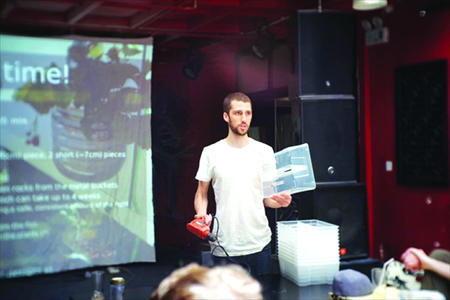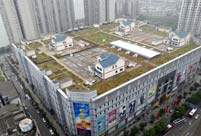 |
| Tim Quijano. Photo: Courtesy of Alvin Lin |
Fish food
The persistence of food scandals has also driven many to use the limited space in their living rooms and balconies for planting vegetables. The passion for urban farming is also fueled by the quest for organic food. Aquaponics, a farming technology that has been widely applied in Australia, has spread to China.
Like Lü Kejian, Shanghai-based David Li, founder of Xichejian, a hackerspace (public lab for inventors), has also tested every possibility for growing plants at home.
"At first I attempted to grow vegetables in soil. But the soil overflowed, and dropped into the pipeline, resulting in blockages," he recounted. Then he turned to hydroponics, growing plants in water without soil, but the nutrient solution also caused plants to grow in the water pipes. Finally, he learned about aquaponics from the Internet, and invited foreign experts to China to introduce the technology that combines hyrdoponics and aquaculture.
In Beijing, American Tim Quijano has established a small community with his peers to exchange their experience in aquaponics. In July, Quijano ran two small workshops , in which participants built their own aquaponic herb gardens. The workshops attracted dozens of people, with some hoping to share their experiences, and others coming to learn.
The equipment required for the system is simple: A fish tank, fish, a water pump, a light source, and a plastic box to create an upper layer over the water for the plants. The ecosystem works because the fish eat and create waste. The waste and water will be pumped into the upper layer to fertilize and water the plants. The plants in return provide food for the microorganisms in the water that can feed the fish. In the system, plants and fish are edible.
According to data from Aquaponics UK, a non-profit organisation providing support for the growing aquaponics industry, a kilogram of fish food can produce at least 50 kilograms of vegetables and 0.8 kilograms of fish, a great return on investment and effort.
Home grown
For simple DIY projects, popular vegetables include tomatoes, cucumbers, mint, basil and cherry tomatoes, while many breeds of fish are suitable, including tilapia and tiny goldfish, said Li.
Li believes DIY aquaponics is worth promoting among city dwellers because "it solves two problems which often face gardening lovers: pouring too much water on the plants or forgetting to water them."
But there are still interesting failures he has experienced. Once he planted too much mint. He threw three mojito parties within a month. In another mishap, the system was thrown out of whack when the smaller fish were eaten by the bigger tilapia.
Quijano, a special projects director with the Beijing Energy Network, and a Beijing Hackathon organizer, told the Metropolitan in an email that when he found a fish tank in his apartment that he moved into this year, he thought it was perfect to "experiment with a more space-efficient gardening method, aquaponics." He noted that in the US, aquaponics is a more "DIY/hobby practice - think eccentric, middle-aged dads ."
"I had made every possible mistake that I could," says Quijano. "Thus, I thought sharing my advice could be valuable for others." Although still in the early stages, DIY home gardening in cramped spaces has become a new trend in China. On the Internet, various forums and communities are providing platforms for many gardening lovers to share their experiences and exchange ideas. These efforts may sound utopian or quixotic, but they reflect the high demand for a greener lifestyle among many city folks.
"When plants become closer to us, they will play a more important role in our daily lives," said Lü.

 Int'l Military Music Festival kicks off in Moscow
Int'l Military Music Festival kicks off in Moscow Army aviation brigade in actual-troop drill
Army aviation brigade in actual-troop drill Top 10 Chinese provinces for the well-heeled
Top 10 Chinese provinces for the well-heeled  Baby born to save his sister - the story of a savior sibling
Baby born to save his sister - the story of a savior sibling Lady of mystery: Female SWAT team in prison disclosed
Lady of mystery: Female SWAT team in prison disclosed  Single mother, baby live in KFC restaurant for months
Single mother, baby live in KFC restaurant for months Fan Bingbing poses for Malaysian magazine Citta Bella
Fan Bingbing poses for Malaysian magazine Citta Bella Zhang Xinyi covers COSMOPOLITAN
Zhang Xinyi covers COSMOPOLITAN A collection of bizarre rooftop buildings around China
A collection of bizarre rooftop buildings around China Egyptian forces step up crackdown campaign on smuggling tunnels
Egyptian forces step up crackdown campaign on smuggling tunnels China, U.S. conduct joint anti-piracy drill
China, U.S. conduct joint anti-piracy drill  'Abandoned' life in cement boats in Huai River
'Abandoned' life in cement boats in Huai River 2013 Taiwan Int'l Tourism Expo kicks off in Taipei
2013 Taiwan Int'l Tourism Expo kicks off in Taipei Photo story: Take a gap year
Photo story: Take a gap year Nokia's Global Headquarters: visiting a declining empire
Nokia's Global Headquarters: visiting a declining empireDay|Week|Month